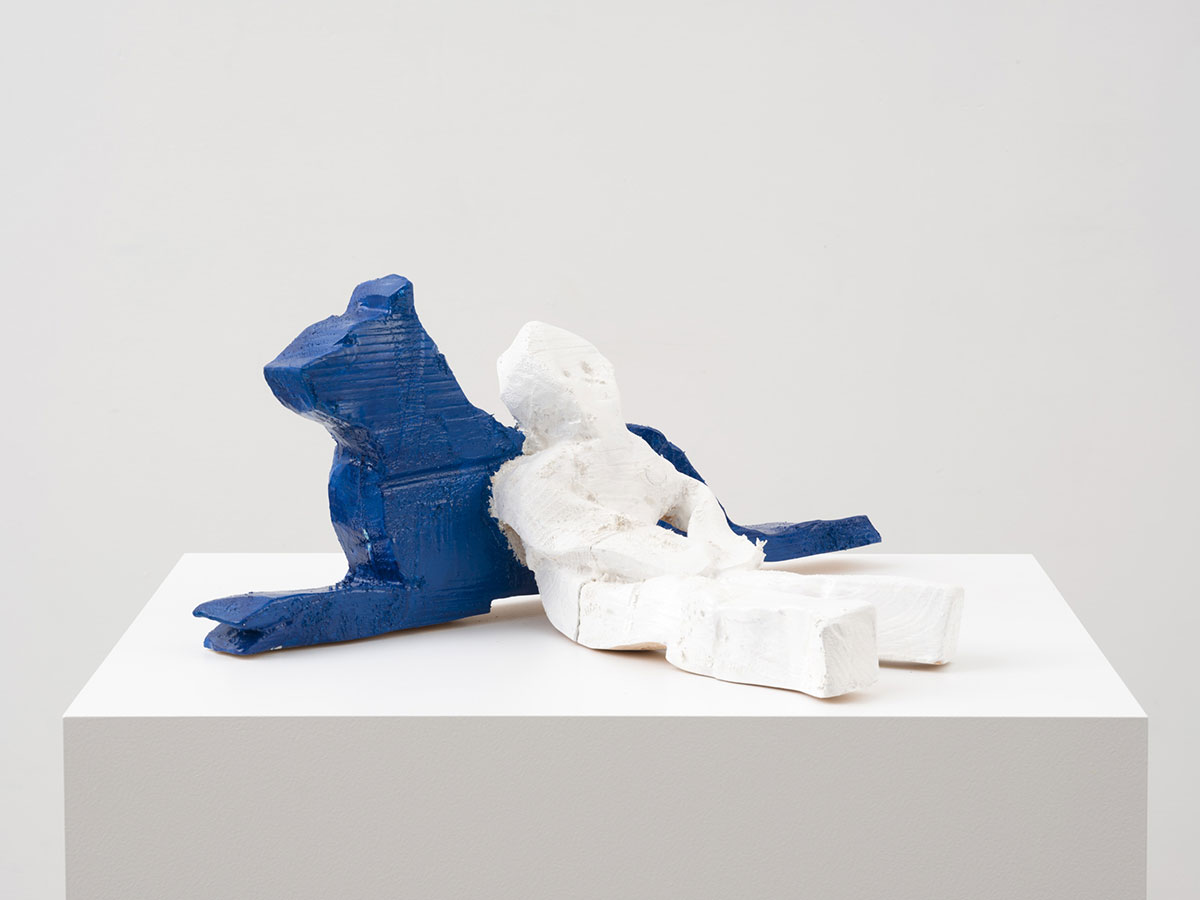PRESENTATION: Valentin Carron-Barking Panting Sighs Heavenly
 Valentin Carron has become known for sculptural work in which ubiquitous cultural icons, particularly those associated with the rural area of his native Martigny, Switzerland, are transformed into objects brimming with humor and pathos. He appropriates seemingly ubiquitous forms and recreates them, so that objects emptied of their significance over time are re-energized and re-awakened.
Valentin Carron has become known for sculptural work in which ubiquitous cultural icons, particularly those associated with the rural area of his native Martigny, Switzerland, are transformed into objects brimming with humor and pathos. He appropriates seemingly ubiquitous forms and recreates them, so that objects emptied of their significance over time are re-energized and re-awakened.
By Dimitris Lempesis
Photo: David Kordansky Gallery Archive
In “Barking Panting Sighs Heavenly”, Valentin Carron explores the romanticized loneliness often associated with the lives of artists. A group of sculptures in which humanoid figures are accompanied by dogs reflects his ongoing interest in motifs whose appeal is universal but whose roots are local or personal. He produced the forms using children’s modeling clay; after baking them in his home oven, they were scanned and then either robotically carved in wood or cast in aluminum at human scale. As some of their titles indicate, these figures are distinguishable as either adults or children, but show no other legible markers of identity. This allows them to be read as the products of a bare kind of expression that privileges directness and simplicity. It also allows them to resonate with a wide range of classical, contemporary, and vernacular representations that appear throughout the histories of art and literature. At the same time, its rawness is somehow both sordid and metaphysical—a reminder that artistic renditions of solitude can be as cheerless and matter-of-fact as they are poetic and spiritual. Their ethos is equally indebted to Daniel Buren’s reduced visual language of stripes, the desolate subjects in Pablo Picasso’s Blue Period paintings, and the earthy characters encountered in stories by the Swiss writer Robert Walser. As in his previous works, Carron’s interest in techniques of material substitution persist; in this case, the transubstantiation of children’s modeling clay into aluminum and wood. If earlier projects found him employing such techniques to tease out questions about the fraught dynamics between authenticity, artifice, and kitsch in contemporary life and historical memory, here he adopts a more overtly reverent stance toward the development of sculptural forms throughout the ages. Instead of serving conceptual and appropriation-based aims, these processes are now representative of an earnest curiosity about the possibilities of rendering ancient forms using new technologies. This allows him to draw a through-line connecting otherwise distant historical periods, especially since there is also a gentle Pop inflection to his choices of materials, which reflect those used in commercial and industrial practices more broadly. At the same time, the sculptures’ classical sensibility is emphasized by their scale and arrangement in the gallery, revealing additional layers of Carron’s interest in exploring primary influences and sources of artistic form. These include ancient Etruscan art, well known for its remarkable tradition of figurative sculpture, and in particular, for its elaborate sarcophagi for married couples, which depict the people buried within them. Carron renders his interspecies pairs with similar attention to the close emotional bonds and reciprocal care involved in such long-term relationships. As the first animal ever domesticated by homo sapiens, dogs have come to represent “man’s best friend”—when Odysseus returned home from ten years of war and wandering in The Odyssey, he was recognized by only his faithful dog Argos. Among other things, the exhibition is an investigation of what it means for things to feel familiar. Carron deftly points to the fact that the artistic longing to make something is often driven by a desire to make friends with impulses and emotions which originally present as strange, disturbing, or alien. The figures on view toggle back and forth between such extremes, with each aspect of their construction—including their material presence, their off-kilter and yet forthright sense of color, and their portrayals of various permutations of human/animal relationships—keying recognizable associations even as it suggests that the things and situations people know best are never quite what they seem. If art has been a means of confronting this contradiction throughout the ages, it too remains an essentially mysterious endeavor. Carron’s concentration on simplicity and recognizability, and on the primacy of his own struggles to define the meaning of his chosen vocation, allows him to delight in this paradox, and to address its unsettling ramifications with humor and humanity.
Photo: Valentin Carron, Child and Dog (lying), 2022, larch wood, enamel paint, 10 1/4 x 24 1/2 x 16 1/2 inches, (26 x 62.2 x 41.9 cm), unique in a series of 3 with 1 AP, © Valentin Carron, Courtesy the artist and David Kordansky Gallery
Info: David Kordansky Gallery, 5130 W. Edgewood Pl., Los Angeles, CA, USA, Duration: 27/5-1/7/2022, Days & Hours: Tue-Sat 10:00-18:000, www.davidkordanskygallery.com/

Right: Valentin Carron, Adult and Dog, 2022, bronze, enamel paint, 11 1/4 x 4 x 3 inches, (28.6 x 10.2 x 7.6 cm), unique in a series of 3 with 1 AP, © Valentin Carron, Courtesy the artist and David Kordansky Gallery



Right: Valentin Carron, Adult and Dog, 2022, larch wood, enamel paint, 35 1/2 x 12 1/2 x 9 1/2 inches, (90.2 x 31.8 x 24.1 cm), unique in a series of 3 with 1 AP, © Valentin Carron, Courtesy the artist and David Kordansky Gallery


Right: Valentin Carron, Baby and Dog, 2022, bronze, enamel paint, 6 3/4 x 6 1/2 x 2 3/4 inches, (17.1 x 16.5 x 7 cm), unique in a series of 3 with 1 AP, © Valentin Carron, Courtesy the artist and David Kordansky Gallery
